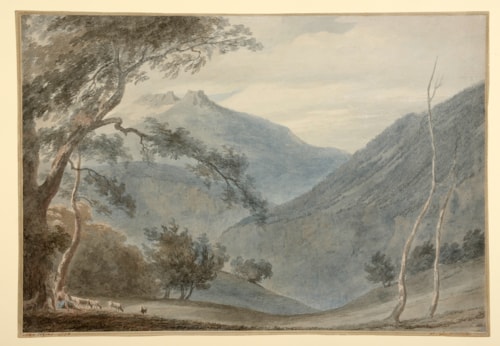
John Robert COZENS
London 1752 - London 1797
Biography
‘All poetry…the greatest genius that ever touched landscape.’ The painter John Constable’s opinion of the work of John Robert Cozens reflects something of the esteem in which his watercolour landscapes were held long after his death. The only son and pupil of the drawing master Alexander Cozens, John Robert Cozens first exhibited at the Society of Artists in 1767 and continued to do so until 1771. In 1776 he made his first trip to Italy, thirty years after that of his father. In the company of the scholar, antiquarian and collector Richard Payne Knight, the younger Cozens travelled through Switzerland and the Alps before arriving in Rome in November 1776. He was to stay in Rome for almost two and half years, until April 1779, making sketching tours of the Roman countryside, often working alongside the Welsh artist Thomas Jones. It was also in Rome that Cozens worked up his Swiss alpine sketches into larger, atmospheric watercolours for Payne Knight and other patrons.
A second trip to Italy in 1782-1783, in the retinue of the wealthy collector William Beckford, resulted in Cozens spending several months in Naples, and then in Rome, and producing a series of almost a hundred finished watercolours of Italian views for Beckford that can be counted among his finest works. Cozens’ health deteriorated in the 1790s, however, and in 1794 he suffered a severe nervous breakdown. He was admitted to the Bethlem Royal Hospital asylum and there placed under the care of the physician and collector Dr. Thomas Monro, who had many of Cozens’s Continental sketches copied by younger artists such as J. M. W. Turner and Thomas Girtin. Cozens died in London in December 1797, at the age of just forty-five.
Cozens seems to have worked exclusively as a draughtsman, and almost no oil paintings by his hand are known. (A now-lost painting of Hannibal Crossing the Alps was exhibited at the Royal Academy in 1776; the only occasion that he showed his work there.) Although his reputation was based solely on his work as a watercolourist, none of Cozens’s works were engraved, with the result that there was no wider dissemination of his compositions through the medium of reproductive prints. Nevertheless, his watercolours were to be enormously influential among the succeeding generation of English landscape draughtsmen.
For most of his relatively brief career of some twenty years, Cozens worked in a limited palette of light blues, greens and greys, avoiding vivid effects and contrasts in favour of a tonal, atmospheric approach to landscape. As Timothy Wilcox has remarked, ‘the near monochrome watercolours of Cozens…opened up unforeseen possibilities - not only to Turner, but to an entire generation of painters exposed to his work at the London house of Dr Thomas Monro. Monro employed Turner, Girtin and other young artists, including John Varley and John Sell Cotman, to make copies of compositions by Cozens. It was less the subjects themselves, scenes in the Roman Campagna or the Bay of Naples, than the subtlety of Cozens’s wash technique which made the greatest impression; through the extreme refinement of his graduated colour, Cozens evoked the fabled clarity of the Italian atmosphere, and an almost infinite spatial recession.’



